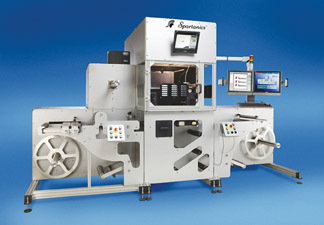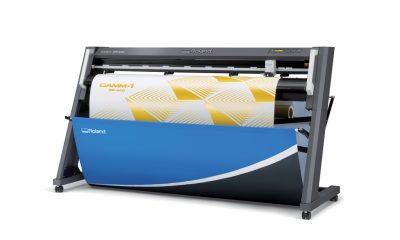Graphics Printing
Published
14 years agoon
The measure of any printer seems to be how practically he can take on most any project. The beautiful artwork, the pressing social calls for action, and compelling P.O.P. advertisements can all be produced on wide-format inkjet. To give some perspective on a wide range of projects, we asked printers to share their latest, most recent award-winning applications. Here’s what we received in response.
The measure of any printer seems to be how practically he can take on most any project. The beautiful artwork, the pressing social calls for action, and compelling P.O.P. advertisements can all be produced on wide-format inkjet. To give some perspective on a wide range of projects, we asked printers to share their latest, most recent award-winning applications. Here’s what we received in response.
Visual Marking Systems, Inc.
Twinsburg, OH
Ron Gizzo, director of R & D
VMS produces pressure-sensitive and four-color-process labels, decals, nameplates, overlays, embossed keypads, static-cling displays, and more. They’re in business to help companies gain a significant edge with innovative markings.
VMS won an Inca Digital Excellence Award (IDEA) this year in the Product Decoration and Specialty Products category. The challenge of their product was to print quality graphics on surfaces that could endure extreme bending. VMS submitted a pair of Horton Crossbow Limbs (Figure 1) and won an award judged on quality, creativity, and delivery.
VMS decorated the crossbow limbs with a licensed camouflage image, which made color matching and pattern repeatability very important. The decorated limbs needed to accept a supplied matte clear coat sprayed in a paint booth. VMS employees completed the print job on an Inca Spyder 320+W, printing first with a white undercoat followed by a four-color process graphic on a limb shaped flat on the front side and slightly curved on the back.
Printing on the crossbow presented a series of challenges for VMS. First, the printer had to select the appropriate print mode and level of cure needed to ensure the ink adhesion required to pass a one-million plus actuation test. Designing a fixture to hold the limbs during printing represented the next challenge, which VMS met by developing a 120-up fixture. The third hurdle was determining how to place the graphical elements and text on the limb. The curved shape on the rear of the limb made it difficult. The final hurdle was loading, unloading, and packaging 120 limbs/bed with efficiency. At the end of the project, VMS eliminated a problem for their long-time customer, Horton, and helped provide the company with an additional competitive advantage.
“Our partnership with Fujifilm and being able to tap their knowledge of ink and UV technology was very helpful to successfully meeting this challenge for our customer,” says Ron Gizzo, director of R&D, VMS.
VMS invested in flatbed UV inkjet printing in 2006 when the company purchased the Inca Spyder 320+W from Fujifilm Sericol USA. Since then, the Inca Spyder has been an integral component in the development of new markets and customers for the company. VMS has been able to expand its printing capabilities to include direct printing on a product, the method used when printing the Horton Crossbow limbs.
Butler Technologies, Inc.
Butler, PA
Glenn Farrell, vice president
Butler Technologies, Inc. has produced user-interface products for the past 20 years. In the early years, Butler handled traditional screen printing to manufacture membrane switches, labels, and overlays using conventional and UV ink technologies.
Looking at emerging technologies, the company incorporated plotter and laser cutting into its finishing department and began to look at the potential of the emerging digital print market. At that time, seven years ago, there weren’t that many digital devices to meet the resolution demands of Butler’s industrial market. However, the company found a match in the Mimaki 605C. The printer had a 25 x 20-in. bed that accommodated the company’s normal sheet sizes and allowed the use of the same three-point registration they were accustomed to using in the screen-printing process. These two facts made all the difference. Farrell says the dual heads for white created the right opacity in just one pass, the RIP software was intuitive, the light cyan and light magenta provided a wide color gamut, and laser-gap head-height adjustment prevented printhead crashes.
The plan was to use the Mimaki digital printer to meet quick turnarounds and make prototypes, but according to Farrell, they have been able to produce graphically appealing products through photorealistic color that fit more than the initial intended application. Butler has also been able to generate variable data, such as bar codes and sequentially numbered products, with the Mimaki 605C, which had always been a cumbersome process for the company with screen printing.
Butler also used the inkjet printer to enhance low-volume graphics applications. Farrell says one customer embraced the digital capabilities and implemented an entire product-line design change based on the versatility of the unit (Figure 2). Changes in overlay graphics were incorporated to produce a unified look, making it easy to see a link between products.
Intergraphics Decal Ltd.
Winnipeg, Canada
Thane Smith, R&D quality manager
Intergraphics Decal prides itself on the ability to fulfill almost any printing challenge, including full-color graphics on a branded fleet of vehicles, safety decals with life-saving information, wine labels, faceplates with custom instructions, Dymoflex logos, or floor graphics.
The company’s 100 employees create prints, decals, and product markings for a wide range of customers in Canada, the U.S., and Europe. Every project is customized, which keeps Intergraphics’ in-house graphic-design department, sales management, and executive staff busy. What started in 1969 as a small operation has grown to be a modern facility with offices in here and abroad. The company is ISO 9001 and ISO 14001 certified for quality and environmental management systems, respectively.
Many companies use vehicle wraps to convey their corporate involvement in the community (Figure 3), and this is one example of the kind of work now seen by Intergraphics from companies combining advertising with projects at the local, national, and international level. The customer supplies the artwork, the design department at Intergraphics sizes the image to fit the vehicle, and the operator of the Agfa Jeti 3324 printer tests it for color accuracy, and prints it on adhesive-backed vinyl. Then it’s laminated, trimmed, applied to the vehicle. The vinyl material used was 3M 180C-10 with Comply adhesive, which is formulated for bubble-free application.
A trend today is to do more community-based advertising, and this fits Intergraphics’ manufacturing capabilities. The shop’s range of digital printing and cutting equipment continues to grow along with the needs of the marketplace and build on a solid foundation of medium- and large-format, high-volume screen printing.
Virtuoso Graphics
Houston, TX
Thomas Wink, owner
Thomas Wink of Virtuoso Graphics recently designed a wall wrap for the sandwich shop Trios. Trios contracted with Virtuoso to do all of the graphics, including indoor signage, window graphics, banners, and cut-letter signage. Trios hadn’t planned on adding a wall wrap for their first shop in the Houston area, but after applying paint, they felt that it needed something more. Wink suggested a wrap and created the design for one (Figure 4).
“We felt that a wall wrap would really bring together all the graphic elements in the shop and reinforce their branding strategy,” Wink says.
Virtuoso Graphics specializes in signs, banners, large-format printing, and graphic design. They have three Roland digital printer/cutters: the VersaCAMM VP-300, VersaCAMM SP-540, and the VS-640, a model that can print metallic silver ink.
Wink says he used the Roland VersaCAMM SP-540 54 in. digital printer/cutter for this job because of its speed, accuracy, and size. Wink used artwork from Trios and designed a wall wrap in Adobe Illustrator measuring 14 x 32 ft. The design included PMS colors that required matching. Wink printed the wrap on Photo Tex fabric media in a series of 48-in. panels once Trios signed off on the design and color match. The wrap took two days to install.
Mills Display
Sydney, Australia
Trey Bailey, account project co-coordinator
Another restaurant wall graphic produced on a wide-format inkjet that stands out is one from the distant continent of Australia. Mills Display (a Styrox Signage Co.) makes display and point-of-sale graphics in Sydney, Melbourne, and Brisbane. Mills specializes in product presentations and visual communications for the retail environment. The company also screen prints (rigid materials only), fabricates of signage, and works in design and production.
Outback Steakhouse challenged Mills Display to create a theme-based graphic for its restaurant walls. The restaurant brand has become successful in Australia and wanted to create an image of wide-open natural places under sunny skies. They came to Mills to produce their wall art. The original art was created by local designers to be consistent with the Outback theme, but with local, authentic elements. The artwork had to appear to be rustic, but nicely finished and hung precisely to present a clean look. The company asked Mills to print directly onto distressed 0.375-in. plywood.
At first, Mills was a bit nervous to print the graphic on its Inca Columbia flatbed inkjet printer. Mills applied a white basecoat to get the inks to pop on the plywood. The artwork (Figure 5) features red tones, where-as other similar displayed walls highlight blues and purples.
“The project had its challenges,” says Trey Bailey, account project co-coordinator. “Plywood tends to bow, especially when 3-m sheets are delivered on 2.4-m pallets. To make certain the printheads went undamaged, we placed the bow upside-down onto the vacuum bed. With careful loading, each board held its place on the Inca Columbia vacuum table and printed well.”
Each art panel was printed on one piece of plywood and then cut into 1-m squares using a CNC router to create the finished piece. “It’s like a collage,” Baily says. “Each square is an individual panel and goes together like a puzzle.”
Ad Art Co.
Vernon, CA
Joe DeMarco, co-owner
In 1992, Joe DeMarco, a CFO, and Roger Keech, a CEO for a large investment firm decided to form a partnership, buy a company, and run it. They had no particular knowledge of printing; they just knew that they were tired of investing in many different companies and were ready to make a company of their own successful. They purchased a traditional screen company, Ad Art Co., outside of Los Angeles.
Over the years, Ad Art has moved forward progressively, adding equipment and technically oriented people with solid work ethics as needed to support diversity in projects. The company operates as a one-stop-shop for unique P-O-P solutions traditionally produced by screen printing and litho. Just recently, though, Demarco and Keech made a $5 million investment in inkjet equipment, purchasing two HP Scitex FB7500 printers, an HP Scitex TJ8550, an XL 1500, and an XP2750.
“We still handle litho and screen printing, which is all direct-to-screen, as well as creative and finishing, such as sewing and die cutting,” DeMarco says. “Investing in five additional digital printers helps with speed and efficiencies needed to reduce turnaround times and help with low-volume, customized, large-format graphics for worldwide clients.”
He explains the company had to spread out and plan the layout, add room filters, and make other adjustments to accommodate the equipment. A lot of Ad Art’s accounts say they want to see a one-off before they give the company the business—a request that Ad Art can now fulfill.
One promotional campaign from Build-a-Bear Workshop (Figure 6) was tied to the Ice Cream Bears collection, which included printed pieces printed on 0.187-in.-thick foamcore and 13-oz. vinyl substrates. At the close of the campaign, Ad Art delivered 1200 double-sided displays and banners, or 27,780 sq ft of printed graphics to the customer.
“Everyone wants everything yesterday, included printed products. And if you don’t take the business, someone else will. Last year in a down economy, print buyers were looking for a deal,” DeMarco says. “We have been successful with new accounts, especially with smaller print companies going out of business and with buyers interested in faster service, high quality, and lower prices. We’ve been working 24/7 for the past three months, but I’m not bragging. Because I have a financial background, I know that there’s never a time to sit back and enjoy success. You always need to stay ahead of the game. Our next step is to keep up with enhancements. Persistence is the name of the game along with service.”
Future trends
Traditional shops still need to be creative to be competitive and profitable by offering customers the latest in technology and the most unique products. One wide-format inkjet product is currently undergoing rigorous qualification testing for adhesion, abrasion, and durability by Gerber Scientific Products. It’s a printed entryway carpet produced on the Gerber CAT UV, a wide-format UV inkjet printer that prints cationic inks.
Every business has an entryway, and that’s one place to advertise to customers as they come and go. The mat pictured in Figure 7 was printed on the Gerber CAT UV. The substrate was UltraCarpet Extra from Ultraflex, a white, tufted-pile carpet especially made for solvent, eco-solvent, and UV inkjet printing. Printing on the carpet is possible because the Gerber CAT UV can print on heat-sensitive materials. The final product can be used indoors for floor mats in lobbies and foyers.

Subscribe

Magazine
Get the most important news
and business ideas from Screenprinting Magazine.
Most Popular
-

 Case Studies2 months ago
Case Studies2 months agoHigh-Density Inks Help Specialty Printing Take Center Stage
-

 Art, Ad, or Alchemy2 months ago
Art, Ad, or Alchemy2 months agoF&I Printing Is Everywhere!
-

 Andy MacDougall2 months ago
Andy MacDougall2 months agoFunctional and Industrial Printing is EVERYWHERE!
-

 Columns3 weeks ago
Columns3 weeks ago8 Marketing Mistakes Not to Make When Promoting Your Screen Printing Services Online
-

 Editor's Note3 weeks ago
Editor's Note3 weeks agoLivin’ the High Life
-

 Marshall Atkinson3 weeks ago
Marshall Atkinson3 weeks agoHow to Create a Winning Culture in Your Screen-Printing Business
-

 Thomas Trimingham2 months ago
Thomas Trimingham2 months ago“Magic” Marketing for Screen Printing Shops
-

 News & Trends2 months ago
News & Trends2 months agoWhat Are ZALPHAS and How Can You Serve Them in Your Print Business?






